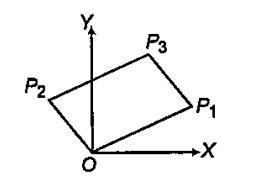Two points P and Q in the argand plane represent the complex numbers z and 3z+2+u. If |z|=2, then Q moves on the circle, whose centre and radius are (here, i2=−1)
−2+i,6
2−i,3
2+i,6
2+i,2
The correct Answer is:C
To solve the problem, we need to find the center and radius of the circle on which the point Q moves in the Argand plane, given the complex numbers z and 3z+2+i.
1. Understanding the Given Information:
We have two complex numbers:
- z (represented by point P)
- 3z+2+i (represented by point Q)
We also know that |z|=2.
2. Expressing z:
Since |z|=2, we can express z in terms of its real and imaginary parts:
z=x+iy
where x2+y2=4 (because |z|2=x2+y2=22=4).
3. Finding Q:
Now, substituting z into the expression for Q:
Q=3z+2+i=3(x+iy)+2+i=3x+2+(3y+1)i
Thus, the coordinates of Q in the Argand plane are:
Q=(3x+2)+(3y+1)i
4. Setting Up the Circle Equation:
Let h=3x+2 and k=3y+1. We can express x and y in terms of h and k:
x=h−23,y=k−13
5. Substituting into the Circle Equation:
Since |z|2=4, we substitute x and y into the equation:
(h−23)2+(k−13)2=4
Multiplying through by 9 gives:
(h−2)2+(k−1)2=36
6. Expanding the Equation:
Expanding the equation:
(h2−4h+4)+(k2−2k+1)=36
This simplifies to:
h2+k2−4h−2k+5=36
Rearranging gives:
h2+k2−4h−2k−31=0
7. Identifying the Center and Radius:
This is the equation of a circle in the form:
x2+y2+2gx+2fy+c=0
where:
- g=−2
- f=−1
- c=−31
The center (h,k) is given by:
(−g,−f)=(2,1)
The radius r is given by:
r=√g2+f2−c=√(−2)2+(−1)2+31=√4+1+31=√36=6
Final Answer:
- The center of the circle is (2,1) or 2+i.
- The radius of the circle is 6.
We have two complex numbers:
- z (represented by point P)
- 3z+2+i (represented by point Q)
We also know that |z|=2.
Since |z|=2, we can express z in terms of its real and imaginary parts:
z=x+iy
where x2+y2=4 (because |z|2=x2+y2=22=4).
Now, substituting z into the expression for Q:
Q=3z+2+i=3(x+iy)+2+i=3x+2+(3y+1)i
Thus, the coordinates of Q in the Argand plane are:
Q=(3x+2)+(3y+1)i
Let h=3x+2 and k=3y+1. We can express x and y in terms of h and k:
x=h−23,y=k−13
Since |z|2=4, we substitute x and y into the equation:
(h−23)2+(k−13)2=4
Multiplying through by 9 gives:
(h−2)2+(k−1)2=36
Expanding the equation:
(h2−4h+4)+(k2−2k+1)=36
This simplifies to:
h2+k2−4h−2k+5=36
Rearranging gives:
h2+k2−4h−2k−31=0
This is the equation of a circle in the form:
x2+y2+2gx+2fy+c=0
where:
- g=−2
- f=−1
- c=−31
(−g,−f)=(2,1)
The radius r is given by:
r=√g2+f2−c=√(−2)2+(−1)2+31=√4+1+31=√36=6
- The center of the circle is (2,1) or 2+i.
- The radius of the circle is 6.
Topper's Solved these Questions
Similar Questions
Knowledge Check
Let 3−i and 2+i be affixes of two points A and B in the Argand plane and P represents the complex number z=x+iy. Then, the locus of the P if |z−3+i|=|z−2−i|, is
Acircle on AB as diameterBthe line ABCthe perpendicular bisector of ABDnone of thesePoint P represent the complex number z=x+iy and point Q represents the complex number z+1z. If P moves on the circle |z|=2, then the eccentricity of locus of point Q is
A3/5B4/5C3/4D1/2Let 3−i and 2+i be affixes of two points A and B in the Argand plane and P represents the complex number z=x+iy. Then, the locus of the P if |z−3+i|=|z−2−i|, is
Acircle on AB as diameterBthe line ABCthe perpendicular bisector of ABDnone of these
Two points A and B in argand plane represent z and z1=2(z+√3+i) respectively. If A moves on a circle with centre at origin and radius √3 and max.(argz1)−min.(argz1)=mπ find 1m
View SolutionIn a given parallelogram, if the points P1 and P2 represent two complex numbers z1 and z2, then the point P3 represents the number

View SolutionSuppose we are given a point P on the Argand plane represented by the complex number Z, moving anticlockwise along the circle with |z|=2 from the point of complex number 2 to 2i. If ω=z+1z+2, then the path described by Q which represents the complex number ω is/are.
View SolutionThe locus of the points representing the complex numbers z for which |z|−2=|z−i|−|z+5i|=0, is
View SolutionIf P andn Q are represented by the complex numbers z1 and z2 such that |1/z2+1/z1|=|1/z2−1/z1|, then
View Solution
